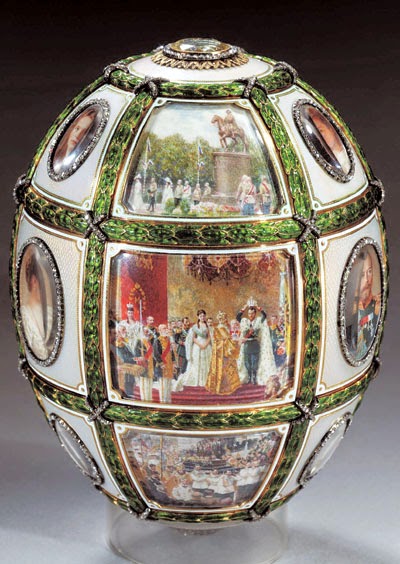Is the Fabergé jeweler still around?
Yes, but Carl Fabergé probably would not recognize its present incarnation. After his death, his sons struggled to resurrect the business, but depression conditions and lack of qualified labor restrained them. While they labored, American opportunist Samuel Rubin caught wind of the Fabergé brand and registered the name for himself, using it to sell perfumes and toiletries.
By the time the Fabergé family heard about this, it was too late. Their money was gone, and they had no means to battle in the American legal system. The American stole their name, and the family walked away with a small settlement. Taken from their hands, the Fabergé name was bought and sold several times, but it was rarely used to represent jeweler's work.
Theo Fabergé (source), grandson of Peter, designed and sold his own Easter eggs (source). Though they are produced in runs of thousands, not one-of-a-kind, they are still quite beautiful and command tens of thousands of dollars in the market. Regrettably, Theo was legally barred from using the Fabergé name to sell them. However, just days before his death in 2007, he and his daughter joined the company named for his family, since it had finally returned to producing jewelry.
In 2007, the Fabergé family was united with the company that had stolen their name over seventy years ago. Two granddaughters of Peter Fabergé, Tatiana and Sarah Fabergé, offer "expertise and guidance" to the Fabergé company, according to Faberge.com. This is more than a publicity stunt, as the two women have been active in the egg business for some time. Sarah Fabergé has practice making and selling luxury jeweled eggs through her father, Theo Fabergé. Her cousin, Tatiana Fabergé, makes a living teaching others about the Fabergé legacy, serving as a historian, educator, and biographer.
Tatiana, left, and Sarah, right (Picture from the DailyMail). The picture was taken in 2009 during the launch of the Fabergé company's first jewelry collection. This occasion was the first time since the 1920s that the Fabergé company sold jewelry. It is also the first time in history that the Fabergé family have worked with the rights-holding Fabergé company.
Today, the Fabergé company operates a handful of boutiques spread around the world, placed in the hubs of the rich and famous. In spite of their egg-centric designs and copious use of diamonds, Peter Fabergé and the csarist splendor are clearly absent. In spite of that, I would be doing you a disservice if I didn't recommend a peek at the company's online galleries. Obviously those rings and necklaces are far too gaudy, the gold excessive and the diamonds, rubies, and emeralds tossed about like grains of sand across a beach...
But I bet it would look really good on you.

Note
I pulled from many sources, mostly news or history sites, in building this series. I've credited many of them here. Some pictures may be uncredited because I could not identify their origin.
Sources
- PBS Treasures of the World: Fabergé Eggs
- PBS Treasures of the World: House of Fabergé
- PBS Treasures of the World: Young Fabergé
- PBS Treasures of the World: Early Eggs
- infoplease: Alexander III
- About.com: 1880 to 1890
- Fabergé: Imperial Eggs
- Fabergé: Peter Carl Fabergé
- infoplease: Alexander III
- CNN: Scrap Metal
- The Link of Times: Fabergé Collection
- moscow.info: Kremlin Armory Museum
- Daily Mail: Perfection, Down to a Tea
- VMFA: Fabergé Revealed
- Metropolitan Museum of Art: Faberge from Matilda Geddings Gray Foundation
- Hillwood Museum: Russian Collection
- Mieks: Eggs
- Walters Museum of Art: Fabergé
- Forbes: Egg Collection Up for Auction
- NYTimes: Russian Industrialist Buys Forbes' Fabergé Eggs
- ArtDaily: Fabergé Museum in Moscow
- petersburgtrip.com: Fabergé Museum Visit
- Guide-Guru: Faberge Egg Museum
- Telegraph: Scandal of the Sheikh
- Independent: Sheikh who Shook up the Art World
- Christie's: Winter egg
- Fabergé: Houston Highlights
- TamuTimes: Dorothy and Artie McFerrin
- Mieks Fabergé
- Encyclopedia Brittanica: Alexander III
- PBS Treasures of the World: Fabergé the Man
- Hillwood Estate: Portrait of Tsar Alexander III
- Wartski: Faberge French Bulldog
- History Learning Site: Nicholas and Alexandra
- BBC History: Nicholas II
- PBS Treasures of the World: Fate of the Eggs
- Rough & Polished: Sarah Fabergé Interview
- Biography: Nicholas II
- JCK: Faberge Returns to Russia











